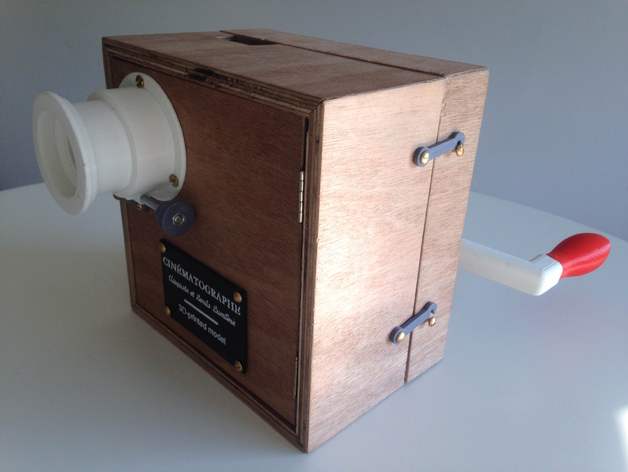
Cinematograph
thingiverse
Introduction The Cinematograph's name comes from ancient Greek words meaning "writing in movement." In 1895, French brothers Lumiere invented their Cinematographe machine. On December 28, 1895, the brothers gave the first commercial public screening of cinematographic films in Paris, making them famous worldwide. With their invention, people from different social classes could enjoy moving pictures. The Cinematograph uses a handcrank and a long strip of film. The film is placed on top of the machine, and by turning the crank, it moves in front of a lens. A light source behind the machine projects the images onto a 16-by-22-meter screen. For more information about the Cinematograph, visit: https://en.wikipedia.org/wiki/Cinematograph The Project The University of Groningen asked me to create a 3D model of the Cinematograph for educational purposes. With only two original machines in the Netherlands, a 3D model will greatly simplify instructions on how to use it. Imagine using the Hololens or Z-space with this technology. Visit: https://sketchfab.com/models/8df1355e552041ada0223acb696abc95 After seeing an original Cinematograph, I fell in love with its mechanism and decided to create a printable version of the device. It took me about a week to design all the parts and make them 3D printer-friendly. I designed it for a 9mm-filmstrip, making this replica usable as a real projector. Building Instructions Download the .pdf-file I created for detailed building instructions. There are 21 different parts that will take approximately 13 hours of 3D printing to complete. The box for the first replica was made in a traditional workshop. For Thingiverse, I designed files so the box can be cut with a lasercutter, saving time and ensuring accuracy. Print Settings Printer: Velleman Vertex K8400 Rafts: No Supports: No Resolution: 0.2 mm Infill: 25% Notes: The file "5. pens" was printed at 0.1mm since these parts are very small. File "6. Big wheel for pen mechanism" needs support to print correctly. Post-Printing Sanding moving parts requires removing layerlines to ensure smooth movement. This is necessary for the following parts: Moving mechanism: only the long ends that move up and down Pen Mechanism: sand down the square blocks First, use a coarse grain like K60 or K80, then polish with a finer grain like K120 and K240 for a satin-like finish. To ensure smooth movement, I used PTFE-spray as a lubricant.
With this file you will be able to print Cinematograph with your 3D printer. Click on the button and save the file on your computer to work, edit or customize your design. You can also find more 3D designs for printers on Cinematograph.
